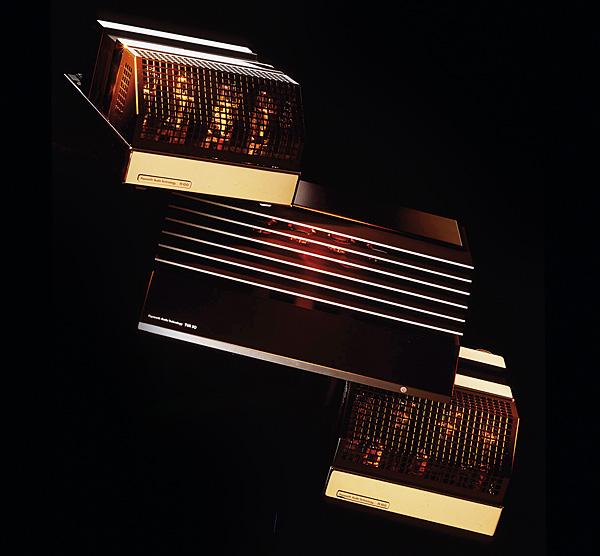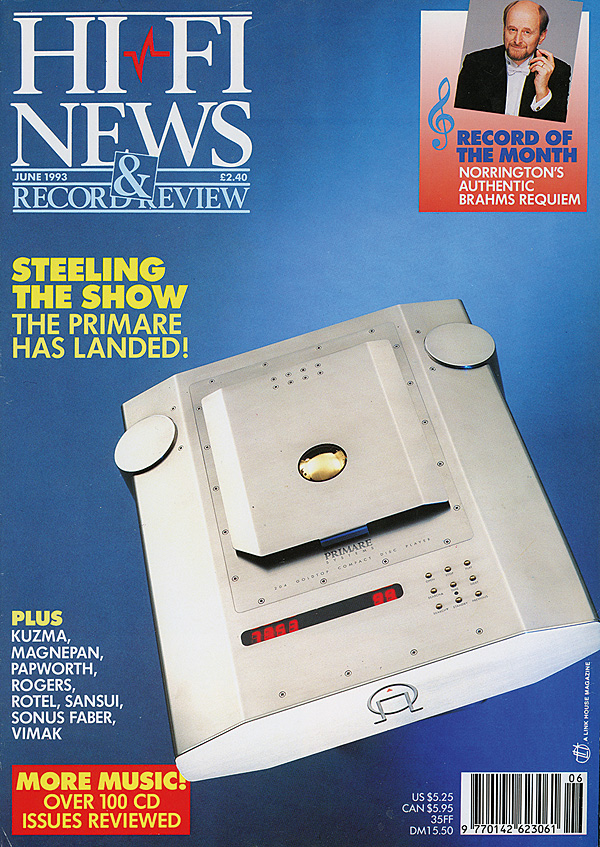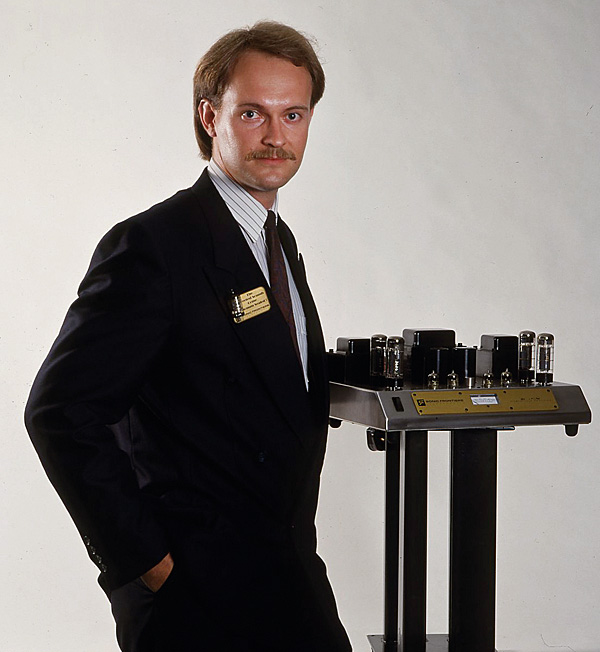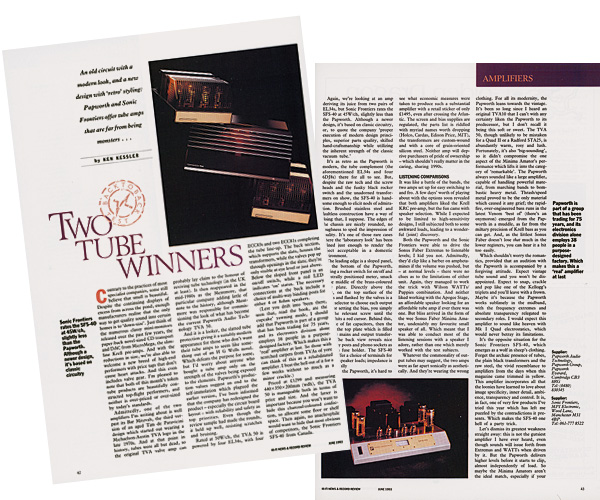Two Tube Winners

 An old circuit with a modern look versus a new design with retro styling as Ken Kessler hears valve amps from Papworth and Sonic Frontiers
An old circuit with a modern look versus a new design with retro styling as Ken Kessler hears valve amps from Papworth and Sonic Frontiers
Contrary to the practices of most specialist companies, some still believe that small is beautiful. Despite the continuing displays of excess from across the Pond, enough manufacturers realise that the only way to get quality sound into certain homes is to 'down-size'.
For example, just think of the numerous classy mini-monitors released over the past few years, the paperback novel-sized CD transport and DAC from Micromega, or the slimline Krell preamps. And with the reductions in size, we're also able to welcome a new breed of high-end performers with price tags that don't cause heart attacks. And this even includes valve gear.
Top Of The Glass
I'm pleased to note that both of this month's token tube products are beautifully constructed top-flight performers, and neither is over-priced or over-sized by today's standards. Admittedly, one of the two amplifiers I'm writing about here is well past its Bar Mitzvah, the third version of an aged Tim de Paravicini design which started out wearing a Michaelson-Austin TVA logo in the late 1970s. And at that point in history, tubes were all but dead, so the original TVA valve amplifier can probably lay claim to the honour of reviving tube technology (in the UK at least).

It then reappeared in the mid-1980s as the Mentmore, that particular company adding little of note to the history, although Mentmore was responsible for commissioning the look of what has become the current Papworth Audio Technology TVA 50 we have here.
Modern Grate
And it is a looker, the slatted tube protection giving it a suitably modern appearance for those who don't want their tube amps to seem like something out of an H G Wells novel. This defeats the purpose for some, but I'd worry about anyone who bought a tube amp only on the strength of the valves being exposed to the elements. Papworth's production values also suggest an end to the self-immolation which plagued the earlier version. I've been informed that the company has redesigned the product – especially the circuit board layout – with reliability and safety as top priorities. Even though the review sample had made the rounds, it held up well, resisting scratches and bruising.
Rated at 50W/ch, the TVA 50 is powered by four EL34s, with four ECC83s and two ECC81s completing the tube lineup. The back section, which supports the slats, houses the transformers. The valves pop up through openings in the slats but they're only visible at eye level or just above. Below the sloped front panel is an on/off switch, while a red LED indicates 'on' status. The connections at the back include a choice of multi-way binding posts for either 4ohm or 8ohm speakers.
Real Deal
Lest you drift into 'been there, seen that, read the book, ate the cupcake' yawning mode, I should add that Papworth is part of a group that has been trading for 75 years, and its electronics division alone employs 38 people in a purpose-designed factory. Which makes this a 'real' amplifier at last. So those with scorched carpets from TVAs of yore can think of this as a rehabilitated amp. I beat the hell out of it for a few weeks without so much as a minor crackle.

Priced at £1299 and measuring 440x200x350mm (whd), the TVA 50 is manageable both in terms of price and size. And the latter is important because you won't want to hide this charcoal-coloured confection, so allocate some floor or shelf space. Then again, no anachrophile would want to hide that most obvious of competitors, the Sonic Frontiers SFS-40 from Canada.
Again, we're looking at an amp deriving its juice from two pairs of EL34s, but Sonic Frontiers rates the SFS-40 at 45W/ch, slightly less than the TVA 50. Although a newer design, it's based on classic circuitry, or, to quote the company 'proper execution of modern design principles, superior parts quality, skilled hand-craftsmanship while utilising the inherent strength of the classic vacuum tube'.
It's as retro as the Papworth amp is modern, the tube complement (the aforementioned EL34s plus four 6DJ8s) there for all to see. But, despite the raw tech and the screw heads and the funky black rocker switch and the unadorned transformers on show, the SFS-40 is handsome enough to elicit nods of admiration. Brushed stainless steel and faultless construction have a way of doing that.
The edges of the chassis are nicely rounded, no roughness to spoil the impression of quality. It's one of those rare cases where the 'laboratory look' has been refined just enough to render the object acceptable in a domestic environment. The leading edge is a sloped panel, like the bottom of the TVA 50, bearing the rocker switch for on/off and a centrally positioned meter, smack in the middle of the brass-coloured name plate. Directly above the meter, on the top surface of the chassis and flanked by the valves, is a rotary selector to choose each output tube for setting the bias – you simply turn the relevant screw until the needle hits a red cursor. Behind this, a couple of fat capacitors, then the rear of the top plate which is filled with the mains and output transformers. The back view, meanwhile, reveals multi-way posts and phono sockets as well as a fuse holder. The SFS-40 doesn't offer a choice of terminals for different speaker loads because impedance is set internally.

Heart Of Steel
As with the TVA 50, it's hard to see what economic measures were taken to produce such a substantial amplifier with a retail sticker of only £1495, even after crossing the Atlantic. The screen and bias supplies are regulated, the parts list is riddled with myriad names worth dropping (Holco, Cardas, Edison Price, MIT), the transformers are custom-wound and with a core of grain-oriented silicon steel. Neither amplifier here will deprive purchasers of pride of ownership – which shouldn't really matter in the caring, sharing 1990s.
![]() Joint Discovery
Joint Discovery
It was like a battle of the bands, the two amps set up for easy switching to and fro. A few days' worth of playing about with the options soon revealed that both liked my Krell KRC preamp, but the fun came with speaker selection. While I expected to be limited to high-sensitivity designs, I still subjected both to some awkward loads, leading to a wonderful (joint) discovery.























































